Michael A. Greenwood, News Editor
The period at the end of this sentence would be colossal next to a quantum dot — like a flea clinging to a good-size dog.
As many as a million quantum dots could perhaps fit within the narrow confines of this circle: o.
In other words, quantum dots are small, but what these semiconductor nanocrystals lack in mass they make up for with myriad other qualities that have researchers, businesses and entrepreneurs imagining a vivid future.
The quantum dots being created today are the culmination of scientific advances that began decades ago and that now allow the atomistic matter to be engineered, designed and applied in ways few early pioneers could have imagined.
Beyond the growing biological uses for quantum dots, there are potentially multiple other applications for the tiny semiconductors that could modernize many areas of light-based technology and touch the lives of nearly everyone in the process.
Quantum dots are being analyzed for uses as diverse as LEDs, lasers, flat screen displays, memory and solar sensors. Some think that they are the tool that will finally outwit the wiliest counterfeiters. They could turn cell phones into boxes that blaze with brilliant colors. Others imagine them being sprinkled over hostile terrain, where they would cling to enemies like invisible parasites, allowing them to be tracked and identified. One analyst predicts that sales of products engineered with quantum dots could reach $500 million within the next five years.
The capabilities of the nanostructures are impressive. They are tunable, highly emissive and durable. They can be modified and manipulated into increasingly complex arrays and incorporated into resins and polymers. They are compact, monochromatic and, although not exactly cheap, are at least starting to become somewhat less expensive. Perhaps most importantly, they are small — very, very small — as little as 2 nm, a size at which the regular laws of physics come undone, and a unique set of properties kicks in. The emitted color can be tuned simply by changing the quantum dot’s diameter or by tweaking its chemical composition (Figure 1).
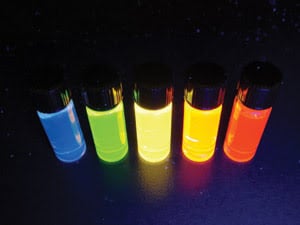
Figure 1. The spectrum of color that can result from quantum dots comes from their different sizes and compositions. Courtesy of Nanosys Inc.
But despite the promise of quantum dots, their revolution has yet to arrive. All of the progress in recent years has not translated into widespread nonbiological applications, leaving many to wonder whether quantum dots have what it takes to make the quantum leap forward into mass production.
“There hasn’t been an enormous breakthrough yet,” said Nathan Tinker, co-founder of the Chicago-based NanoBusiness Alliance, which tracks various nanotechnologies. “I still think there is an enormous opportunity, but it might take a little longer than thought.”
Beautiful colors
Just outside Boston, in the suburb of Watertown, Seth Coe-Sullivan is putting his MIT education to the test at QD Vision Inc. He is chief technology officer and co-founder of the young company, which is seeking to use quantum dots as the basis for the next generation of flat panel displays. Coe-Sullivan and his colleagues have been pushing the capabilities of the nanocrystals to the limit, trying to coax out every bit of performance so that their eventual product will leave liquid crystal, cathode-ray tube and plasma displays looking pallid by comparison. He is confident of success.
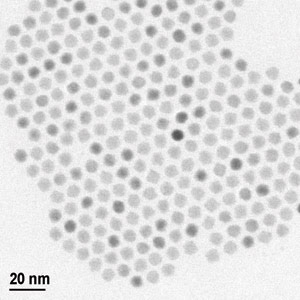
Figure 2. This TEM image shows 6-nm-diameter PbSe quantum dots that self-assembled into an ordered colloidal crystal on the sample substrate; they are separated by 2-nm-long surfactant molecules. Courtesy of Evident Technologies Inc.
“You’ll be able to see the color, the contrast,” he said of the quantum dot-based display, which is still in the research and development stage. “It will make the product jump off the shelf.”
The company’s highly scalable screen relies on a technique discovered while Coe-Sullivan was a student at MIT, and it is still being fine-tuned. After the quantum dots are created through colloidal synthesis, they are assembled out of solution onto a transfer medium. The solvent is allowed to evaporate, and the transfer medium is applied to the display substrate, in essence printing an ultrathin film of red-, green- and blue- emitting quantum dot LEDs, ~2 to 12 nm thick, that provide the display’s subpixel colors (Figure 3).
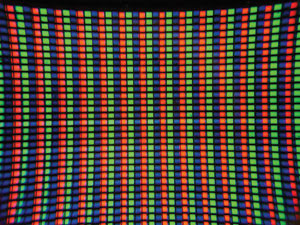
Figure 3. These patterned red, green and blue LEDs using red and green quantum dots on a blue background were deposited using a proprietary printing method. The pixel pitch is 500 μm, and all of the LEDs are operating at the same voltage. Courtesy of QD Vision Inc.
The company says that its quantum dots already exceed the capabilities of LCDs and even the stringent colorimetry standards set by the National Television Standards Committee. Its green quantum dot LED has achieved external quantum efficiencies of 0.81 percent, efficiencies of 2.7 lm/W at a brightness of 140 cd/m2. Its red quantum dot LED has an external quantum efficiency of 3.1 percent and efficiencies of 3.4 lm/W, measured at a brightness of 210 cd/m2 (Figure 4). A blue quantum dot LED has been produced, but its capabilities have not been announced.
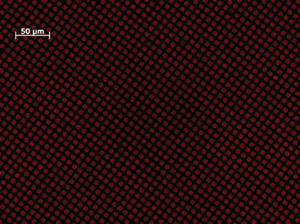
Figure 4. Quantum dot technology is finding use in flat panel displays. Here, a fluorescence microscope image shows a patterned monolayer of red quantum dots on glass with 5-μm-wide feature sizes. Courtesy of QD Vision Inc.
A quantum dot-based display would eliminate the need for backlights and color filters, resulting in less power use — as much as 10 times less — than the current array of display technologies. This technology also could be packaged into screen sizes ranging from the one on a cell phone to a 60-in. display worthy of any Super Bowl party. Coe-Sullivan said that, besides enhanced color and efficiency, their finished product also will feature a thinner and lighter form, making it easier to mount.
But do not rush out looking for this cutting-edge display just yet. Coe-Sullivan anticipates that a working prototype will not be ready until 2009, with commercialization the following year. The company is working on adapting the technology into a high-yield, commercial-grade process. It can manufacture one display at a time right now, but it needs to be able to make hundreds. Coe-Sullivan promises that it will be worth the wait.
Jagdish Rebello, a director and principal analyst for iSuppli Corp., a technology research company based in El Segundo, Calif., agrees that quantum dot LEDs are something the marketplace will need to wait for — patiently.
Researchers have done many interesting things with quantum dots. They have created ones that emit throughout the visible spectrum and across the UV. But this versatility has not translated into practical uses, and it remains unclear to what extent quantum dots are commercially viable. “It is a promising technology. But right now it’s just a promising technology,” Rebello said.
Chic cells
At Motorola Labs in Schaumburg, Ill., Andrew F. Skipor has enough faith in the highly emissive quantum dots to invest substantial time figuring out how they can be used in the next generation of cell phones. If he is right about their potential, the company’s chic cells could become the latest fashion accessory.
Skipor is a member of the technical staff at the electronics company’s physical realization research lab and leads several nanotechnology research programs, including an initiative to create cell phones that not only change colors but also achieve surface hues as gentle and complex as the pattern on a butterfly’s wing. He wants customers to look at the sublime, glowing colors emitting from their phones and say, “Wow! That’s cool.”
Motorola is still working out the details of how the quantum dot-loaded phone might work. It could change colors passively or be prompted by an incoming call to roam the spectrum. The user might be able to adjust the color, perhaps coordinating it to match that day’s outfit or dialing a shade that mirrors a passing mood.
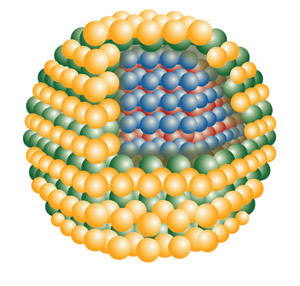
Figure 5. CdSe/ZnS core-shell quantum dots have an inner spherical CdSe semiconductor crystal surrounded by a shell of ZnS semiconductor. Core diameters typically range from 2 to 10 nm, and shell thickness may vary from 0.5 to 4 nm. Courtesy of Evident Technologies Inc.
Skipor is working with free-standing quantum dots, which, unlike those produced on semiconductor wafers, can be manufactured using scalable colloidal solution chemistry. They are made of CdSe/ZnS and range from 2 to 8 nm (Figure 5). One serious hurdle is finding a viable alternative to cadmium compounds. Although nanocrystals created from this material are reasonably priced and offer high performance, they also contain heavy metals and, despite the infinitesimal quantities, would likely be banned from use in a growing number of countries, particularly those in the European Union, where the RoHS directive tightly restricts potentially harmful substances. Motorola is actively seeking for its quantum dots an environmentally friendly material, one that easily can be blended into polymers.
Considering the brutally competitive world of cell phones, Skipor is purposefully vague on the specifics of what has — and has not — been accomplished in the lab with quantum dots. However, he is quite clear that the nanocrystals likely will find their way into company products in the coming years, at least in some capacity. “We see an opportunity, and we think we have the right material.”
Green valley of death
Another problem many researchers continue to grapple with is how to create a vibrantly white LED for use in specific applications. The reds and the blues are up to the task, but the greens have continued to frustrate, leading investigators to christen this stubborn problem the “green hole” or the “green valley of death.”
Ian E. Ashdown, a senior research scientist at TIR Systems Ltd., a solid-state lighting technology company in Burnaby, British Columbia, Canada, said that ideally what is needed is a green LED with a peak wavelength of 540 nm and efficacy of at least 60 lm/W. Right now, the only viable alternative seems to be a phosphor-coated LED with a deep blue emission that peaks at 450 nm or so (Figure 6).
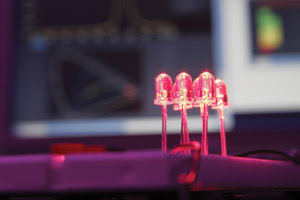
Figure 6. These LEDs have a quantum dot-based nanophosphor coating. The coating was deposited on a 460-nm InGaN chip. Courtesy of Evident Technologies Inc.
If quantum dot manufacturers could produce a phosphor that meets those benchmarks, the product could become competitive in a number of uses, including LCD backlighting and general illumination.
Researchers are addressing this, but the “if” is particularly big. Ashdown said that the quantum dot phosphor would have to have numerous capabilities, including a high quantum yield (in the range of 80 to 90 percent), a narrow emission spectral bandwidth (with broad absorption) and minimal temperature dependency. It also must be free from concentration quenching and clustering and have minimal long-term degradation. In addition, it would have to be RoHS-compliant.
“We shall see,” Ashdown said.
Dot defense
In Troy, N.Y., Evident Technologies Inc. produces an assortment of quantum dots with very specific capabilities, which it sells to researchers and companies around the world. The company also is making forays into several niche applications, including LEDs, security and document protection (Figure 7).
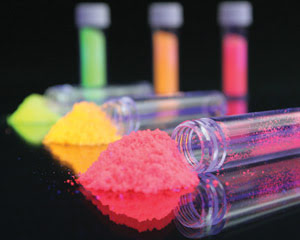
Figure 7. These microparticles consist of micronized polymer-containing quantum dots. Courtesy of Evident Technologies Inc.
Although quantum dots are not widely used for security purposes, the company believes that their unique optical properties offer protection against almost any manner of document theft, fraud or counterfeiting.
Because quantum dots can be tuned to emit over wavelengths from 400 to 2300 nm, it would be nearly impossible for a counterfeiter — even one with the most sophisticated nanotechnology skills and state-of-the-art equipment — to mimic the quantum dot code programmed on the authentic item. Combine dots with different wavelengths, change their concentrations or use different excitation wavelengths, and the encryption becomes exponentially more difficult to unravel.
The material can be integrated into inks, fabrics or paper that can be read with various detection systems. The quantum dots can be fabricated so that their emissive capability lasts indefinitely or disappears within a short time, said Steven I. Talbot, chief marketing officer of Evident Technologies. The durability is up to the customer.
The company actively seeks to market quantum dots as a security technology, but it concedes that there are myriad security tools already being used, so persuading people to switch is not easy. This is especially true in highly sensitive applications such as currency protection. The US Department of the Treasury, for instance, is conservative in its approach, and it is unlikely that it will swap familiar technology anytime soon for the more enigmatic world of quantum dots.
The company also has explored how quantum dots might be used in security and defense applications (such as devices that track suspects or prevent trespassing), but it declined to discuss specifics.
For other researchers, fully exploiting the potential of quantum dots for use in lasers remains the Holy Grail.
Their potential has interested DARPA, which is part of the US Defense Department, enough to sponsor research that could result in quantum dot-based systems that detect chemical agents or that play a role in missile defense.
Program Manager Henryk Temkin is researching how to devise a quantum dot laser that combines a low threshold with high thermal stability for highly specific military and defense applications. It has not been easy. “We don’t understand the trade-offs,” he said. “People have high expectations, but it is difficult to realize. I would say the problem will be overcome.”
Quantum what?
There is an increasingly dense tangle of patents governing quantum dot technology as small startup companies and researchers alike seek to protect their quantum dot turf.
They are saying to themselves, “I’ve got quantum dots, and they can do amazing things. How do I make money from them?” said Edward K. Moran, director of product innovation and leader of Nanotech Industry Practice in New York City.
But so far, at least, not many people have made a lot of money off the tiny backs of quantum dots.
A number of obstacles are in the way. Quantum dots, in just about every case, must replace an incumbent technology. Although this can be achieved, it is challenging to take on entrenched companies and persuade people to give up the familiar and trusted.
In addition, there are few new quantum dot companies entering the fray because of existing competition and the high startup costs involved. Also, aside from certain laboratories and research centers, most people still do not even know what a quantum dot is, let alone what it is capable of doing. And, of course, in many cases the technology still has its bugs.
“The potential markets for quantum dots are huge, but only if these hurdles can be overcome. Consequently, the present demand for quantum dots is still very small,” Moran said. But he believes that that could change quickly if companies such as QD Vision deliver the products that they envision.
John F. Oliver, author of an extensive report for BCC Research, “Quantum Dots: Technical Status and Market Prospects,” agrees. He said the market has developed more slowly than anticipated and estimates current international sales are about $50 million. By 2012, though, that figure could swell to $500 million, with display, solar and memory applications leading the way.
Stephen Empedocles, co-founder and vice president of business development for Nanosys Inc., a Palo Alto, Calif., company specializing in nanotechnology applications, said that the potential of nanotechnology is so vast that it has been easy for researchers to get lost in the wilderness of possibilities. However, many research laboratories have become more focused in recent years, creating multidisciplinary teams needed to solve real-world problems.
“There are not a lot of real blockbuster products out there right now,” Empedocles said, “but I think you are going to see a big influx of products with blockbuster potential in the next year or two.”
A tutorial on quantum dot lasers will be featured in the August issue of Photonics Spectra.
Meet the author
Seth Coe-Sullivan is co-founder and chief technology officer of QD Vision Inc. in Watertown, Mass.; e-mail: [email protected].